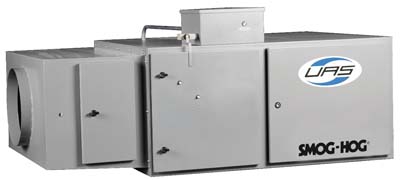
Operating on just 0.7 amps per 1,000 cfm of capacity, Smog-Hog electrostatic precipitators from United Air Specialists Inc. offer one of the lowest-energy, highest-efficiency air cleaning technologies available, capturing up to 99.9 percent of submicron smokes, mists and emulsion oils using washable collection cells. Green advantages for the system include reusable collection cells, minimal fan size, low energy use, make-up air reduction, potential material recycling, and elimination of costs for filter media disposal and replacement.
Smog-Hog mist collectors are available for indoor or outdoor use, for small source-capture applications down to 200 cfm, or large process exhaust streams up to 40,000 cfm. The Smog-Hog is ideal for meeting OSHA and EPA regulations regarding metalworking oil smoke and coolant mists, welding smoke, quenching smoke, plasticizers, cooking smoke, asphalt smoke and similar mists. Smog-Hogs use electrostatic precipitation (ESP) to capture particles down to 0.01µm in size. Depending on system configuration, various prefilters and/or mist-stop filters capture the largest particles first. Smaller particles are electronically charged in an ionizing section and then captured on closely spaced plates in a collecting cell, much the way lint is attracted to a wool suit by static electricity. Cleaned air can be recirculated into the plant, reducing make-up air requirements up to 80 percent to save energy, or the air can be released to atmosphere. Captured liquids drain from the collection cell for convenient disposal, reuse or recycling.
Unlike filtering devices, static pressure of the Smog-Hog is extremely low, about 0.25 inches W.G., requiring only about 1 hp of fan energy per 1,000 cfm of system capacity. Thus, noise, total energy use, and operating cost are extremely low, and fan silencers are eliminated.
Smog-Hog systems can be used ducted or unducted, and smaller models can be mounted directly on machine-tool enclosures. The newest and smallest model, the MSH , includes a variable speed control to minimize energy use and control air flow from 200-600 cfm. MSH units have a total energy input requirement of just 1.4 amps, and their large-capacity ESP cells capture up to four times the amount of machine fluid of similar sized devices.
Larger SHN and SG models handle air volumes of 400-9,000 cfm. SHN and SG models can be machine mounted, but these units are more commonly ducted to machine enclosures or used unducted to clean and circulate air in specific zones of a plant. Many Smog-Hog units come with a high-efficiency mist-stop filter or can be equipped with it as an option. The mist-stop filter dramatically reduces the amount of mist and smoke passing through the precipitator's collecting cell, allowing the units to operate two to three times longer without maintenance. Custom-engineered PSH and PSG models of the Smog-Hog are designed to collect heat-generated organic vapors and particulates from industrial processes, and use a variety of filtering technologies to precondition and clean the most polluted airstreams.
Typical applications involve visible industrial emissions from asphalt coating, CNC machinery, industrial cooking, plastics, textile and rubber processing, as well as soldering, sintering, laser cutting and etching. These modular systems handle airflows of 750-40,000 cfm. The precipitator modules use a low-energy, self-regulating power supply that adjusts voltage based on contaminant loading, ensuring safe and continuous operation at the highest efficiency level. Smog-Hog ionizers and collecting cells utilize a unique airfoil design with convoluted insulators and heavy-duty tungsten ionizer wires for highest efficiency, reduced maintenance and long life.
Contact Details
Related Glossary Terms
- computer numerical control ( CNC)
computer numerical control ( CNC)
Microprocessor-based controller dedicated to a machine tool that permits the creation or modification of parts. Programmed numerical control activates the machine’s servos and spindle drives and controls the various machining operations. See DNC, direct numerical control; NC, numerical control.
- coolant
coolant
Fluid that reduces temperature buildup at the tool/workpiece interface during machining. Normally takes the form of a liquid such as soluble or chemical mixtures (semisynthetic, synthetic) but can be pressurized air or other gas. Because of water’s ability to absorb great quantities of heat, it is widely used as a coolant and vehicle for various cutting compounds, with the water-to-compound ratio varying with the machining task. See cutting fluid; semisynthetic cutting fluid; soluble-oil cutting fluid; synthetic cutting fluid.
- emulsion
emulsion
Suspension of one liquid in another, such as oil in water.
- metalworking
metalworking
Any manufacturing process in which metal is processed or machined such that the workpiece is given a new shape. Broadly defined, the term includes processes such as design and layout, heat-treating, material handling and inspection.
- quenching
quenching
Rapid cooling of the workpiece with an air, gas, liquid or solid medium. When applicable, more specific terms should be used to identify the quenching medium, the process and the cooling rate.
- sintering
sintering
Bonding of adjacent surfaces in a mass of particles by molecular or atomic attraction on heating at high temperatures below the melting temperature of any constituent in the material. Sintering strengthens and increases the density of a powder mass and recrystallizes powder metals.






